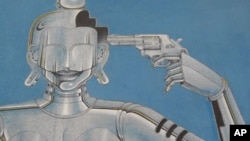A new exhibition at a gallery on the outskirts of Beijing is bringing contemporary Tibetan art to the Chinese public and the rest of the world.
A row of young Tibetan artists stand in front of a towering sculpture of a traditional Tibetan religious object, a stupa. The shape was recognizable, but this stupa is made out of empty beer bottles.
Tseten Kalsang is one of two brothers who created the beer bottle stupa. He says his artwork is about the dialogue between religion, tradition and modernity. He adds that Tibet's tradition already has been portrayed well, so he is trying to show how the modern world also has affected Tibetan culture. He says the beer bottle stupa is an example of how many cultural changes start with alcohol and food.
Another artist - long-haired, middle-aged Penpa - paints self-portraits. The sometimes naked figures are anguished, with eyes that reveal inner anxiety.
Penpa says many people think of Tibet as a backward place, with an art scene dominated by religious paintings known as thangkas. He says this exhibit has given Tibetan artists a chance to show the world that Tibet also has a thriving contemporary art scene, too.
Tension with China on display
The exhibit in Songzhuang, just outside Beijing, is called the Scorching Sun of Tibet. It brings to China's capital a modern look at a region that has long been troubled. Many Tibetans oppose Chinese rule, and complain the Chinese authorities try to repress their culture, which is based on Tibetan Buddhism.
Beijing says it has brought greater prosperity to the region and freed it from ancient feudalism. Still, thousands of Tibetans have followed their spiritual leader, the Dalai Lama, into exile in India.
Tsering Nyandak's paintings depict objects - people and machines - against desolate, almost pastel-colored, backgrounds. One of his works references riots that rocked Lhasa in 2008, which he thinks were not depicted correctly by either Chinese or Western media.
"Back then, media had a crucial role, but they did not portray reality at all. Sometimes, reality can be very specific, very personal, if the things in the news are generalized, then it becomes either political or very ideologically oriented," said Nyandak.
The 2008 riots involved an initially peaceful Tibetan demonstration that turned violent after protesters attacked ethnic Han Chinese residents.
Officials say around 20 people died, but Tibetans say Chinese security forces killed any more Tibetans. Afterward, scores of Tibetans were arrested and Chinese authorities barred most foreigners from going to the region.
At the time of the riots, only Chinese journalists were allowed into Tibet. The government cut off Internet and mobile phone access, which made it difficult to verify what had happened.
Well-known Chinese contemporary art critic Li Xianting is the exhibit's curator. He says he first had the idea to hold it in 2007.
Li says that the events of 2008 had an effect on him, but did not delay the exhibit because the artists needed time to create enough artwork to fill the large Songzhuang Art Museum.
Tibet's traditional culture disappearing
One of Li's favorite works involves a grouping of 30 different Tibetan letters, cast in iron, each lying on separate piles of dirt arranged on the floor. He says he believes written language is an intrinsic part of any culture.
Li says he was surprised to discover that many of the young Tibetan artists in the exhibit did not read or write that well in their own language. He describes this as a "very serious matter," and says he thinks it is, in his words, "a form of control over Tibetans" that there is not enough Tibetan language instruction in their schools.
The tension between tradition and the modern world is the overall theme of the exhibit. One work shows rows of hundreds of small mock clay plaques, covering a wall. They look like traditional Buddhas, but actually are Mickey Mouse figures. In other paintings full of recognizable Tibetan symbols, the figures posed as traditional Buddhas turn out to be men in business suits or curvaceous women in bikinis.
Prayer wheels are ubiquitous to Tibetans, and there are four at the entrance to the exhibit. Instead of covering the wheels with religious mantras, though, the artist uses the names of four generations of Chinese leaders - Mao Zedong, Deng Xiaoping, Jiang Zemin and Hu Jintao - as a way of representing a process of assimilation and change for people in Tibet.












